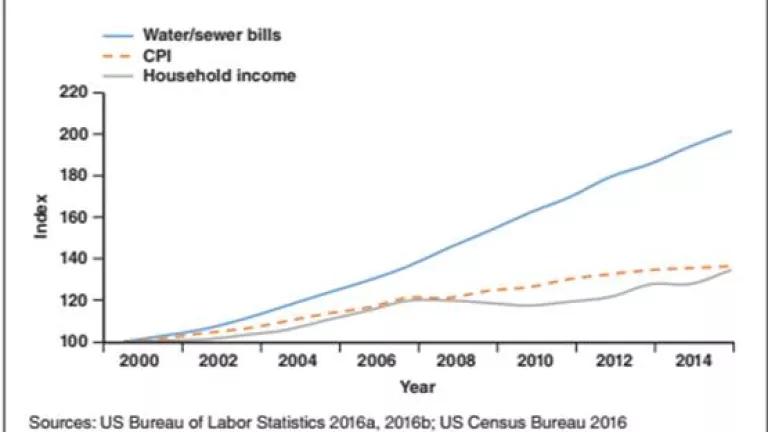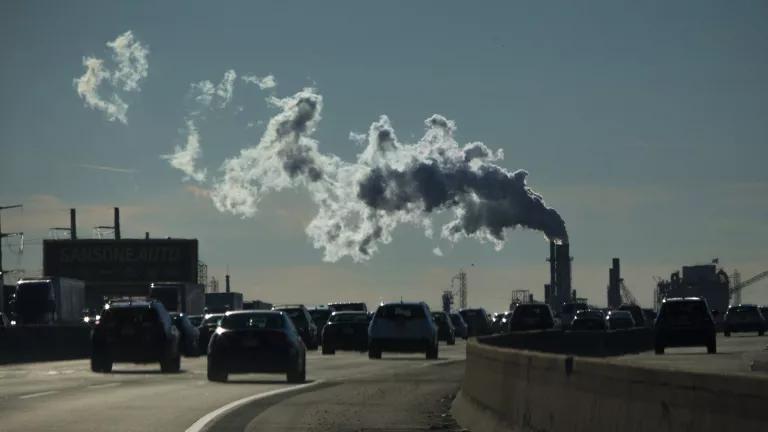We Need Clean and Affordable Water for All New Yorkers
Over the last 15 years, increasing capital investment needs (and decreasing federal financial assistance) have caused water and wastewater rates to rise nationally at about twice the rate of both inflation and income growth.

Growth in Water and Sewer Bills, Consumer Price Index, and Household Income, United States, 2000-2015, from a recent article in the journal of the American Water Works Association.
Today I testified at a joint hearing of the New York State Assembly Committees on Environmental Conservation and Health. On behalf of NRDC, I offered recommendations on many of the most important water issues the state faces, including water infrastructure funding, water affordability, drinking water contamination, source water protection, and more.
The hearing opened with testimony by the state Department of Environmental Conservation (DEC) and Department of Health (DOH). They described the early successes of the state’s landmark $2.5 billion water infrastructure grant program, which helps communities invest in their drinking water, wastewater, and stormwater systems to protect public health and the environment. All of the committee members present expressed their unwavering support for this program.
Not surprisingly, the DEC and DOH witnesses explained that the grant program is “over-subscribed”—there are more grant applications than there are funds available. They also explained that the grants can fund up to 25% of the cost of a capital project, with a required local match to cover the balance. The local match, in turn is usually financed through a low-interest loan from the state’s Clean Water and Drinking Water Revolving Funds.
In my remarks, I emphasized the need to complement the infrastructure grant program with a new low-income affordability program, modeled on the state’s existing energy affordability programs. Over the last 15 years, increasing capital investment needs (and decreasing federal financial assistance) have caused water and wastewater rates to rise nationally at about twice the rate of both inflation and income growth. The available data suggests that New York’s experience is generally consistent with this national trend.
Rapidly rising rates, in combination with slower income growth and rising income inequality, are making water and sewer costs increasingly expensive—as a share of household income—for many low-, moderate-, and fixed-income New Yorkers. And the harms of unaffordable water bills are not only financial. Consequences of unpaid water bills include water shutoffs, which can lead to loss of housing and even temporary loss of custody of children, as well as liens for unpaid bills that ultimately lead to property foreclosure.
As communities in New York raise their water and sewer rates to fund the local share of essential infrastructure investments, the state must ensure that safe, clean water and sewer service remains affordable for all New Yorkers. In my testimony, I highlighted a water affordability proposal (appended to my written testimony) that NRDC put forward this year, along with a coalition of environmental, environmental justice, affordable and healthy housing, low/fixed-income, and economic justice advocacy groups.
I’m pleased to report that my testimony was well-received by the committee members, including Assemblyman Englebright, the chair of the Environmental Conservation Committee, and Assemblyman Gottfried, the chair of the Health Committee. Assemblyman Englebright, in particular, offered his thanks for “thought provoking” remarks and committed that “we will be discussing your proposals.” That’s a good start, and we’re looking forward to opportunities to advance water affordability legislation in the new legislative session that begins in January.
My full testimony is here, and a summary of my testimony is below.
* * * * *
Good morning Chairman Englebright, Chairman Gottfried, Chairwoman Fahy, and members of the Committees and Subcommittee. I am Lawrence M. Levine, senior attorney in the Water Program at the Natural Resources Defense Council (NRDC). I appreciate the opportunity to testify today on behalf of NRDC and our nearly 213,000 members and online activists in New York.
Summary of Testimony
In New York, as in much of the country, our aging infrastructure is simply not up to the twin tasks of providing everyone with affordable access to the safe water, wastewater, and stormwater services they need and keeping our waterways free of harmful pollution. Further, our source waters and recreational waters are threatened by pollution sources both new and old.
To bring New York’s water systems into the 21st Century, and protect the waters of the state for people and the environment, New York needs to continue its significant investments in water infrastructure; add a new focus on the affordability of water and sewer service for low-income customers; adopt new and stronger regulatory standards to protect drinking water sources, prevent exposure to drinking water contaminants, protect surface water quality, and improve water use efficiency; and create new accountability mechanisms and funding mechanisms that give local water, sewer, and stormwater systems the tools they need to succeed.
Specifically, NRDC offers the following recommendations:
- Water Infrastructure Improvement Act: Continue significant state grant funding for water infrastructure.
- Affordable access to clean, safe water, wastewater, and stormwater service: Adopt a new water affordability program to ensure that water and sewer service remains affordable for low-income households, even as utilities generate additional local revenue to meet clean water needs.
- Drinking water contamination: Set an enforceable standard for PFOA and PFOS levels in drinking water as soon as possible and establish clear, effective requirements for public notification when contamination is discovered.
- Source water protection: Pass a resolution calling on the Governor to vote for a full fracking ban in the Delaware River Basin, which includes a ban both on fracking and on the treatment, disposal, and storage of fracking wastewater. (Our stormwater recommendations below also serve to protect source waters from a significant pollution source.)
- Prioritizing investments to save money and water: Adopt model legislation requiring drinking water utilities to perform annual water loss audits using best practice methodologies, and legislation requiring comprehensive asset management programs for both drinking water and wastewater utilities.
- Water efficiency: Adopt pending legislation to require that all new bathroom fixtures meet modern water efficiency standards, and improve implementation of SRF policies intended to spur water conservation.
- Stormwater pollution and flood mitigation: Improve municipal stormwater infrastructure by strengthening DEC’s statewide permit and adopting legislation that empowers local governments to fund effective implementation.
- Protecting recreational waters: Adopt recreational water quality standards consistent with EPA’s recommendations to protect public health and, specifically in New York City, ensure that public concerns with the city’s sewage overflow control plans are addressed to ensure waters in and around New York Harbor achieve those standards.
* * * * *




